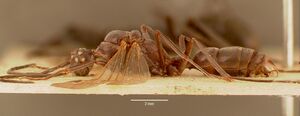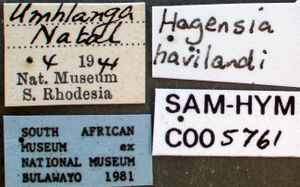Hagensia havilandi
| Hagensia havilandi | |
|---|---|

| |
| Scientific classification | |
| Kingdom: | Animalia |
| Phylum: | Arthropoda |
| Class: | Insecta |
| Order: | Hymenoptera |
| Family: | Formicidae |
| Subfamily: | Ponerinae |
| Tribe: | Ponerini |
| Genus: | Hagensia |
| Species: | H. havilandi |
| Binomial name | |
| Hagensia havilandi (Forel, 1901) | |
| Subspecies | |
| |
| Synonyms | |
| |
Arnold (1951) - The habits of the two species are also very different. Whereas Hagensia peringueyi can be seen on the slopes of Nordhoek wandering about on the ground in the brightest sunlight, havilandi is a crepuscular and nocturnal species. At Umhlanga Rocks, on the Natal coast, during a period of over three weeks, they were never seen moving about during the day time, even in the shade of the dense beach bush, but came out of their nests only some time after sunset. Many nests were found on the sloping banks of the road on the seaward side of the beach bush. The entrance is a small hole, about 5 mm. wide, and recognizable in some cases by the talus of excavated soil at the foot of the slope. There were at least two dozen workers in each nest, in which I was unable to find any remains of their prey.
| At a Glance | • Gamergate • Tandem running |
Identification
Arnold (1951) - This species can be distinguished from Hagensia peringueyi not only by its larger size, but also by the matt surface of the whole body. The sculpture of the head is reticulate-punctate, resolvable under a magnification of 30 diameters, whereas in peringueyi the necessary magnification is from 45 to 50 diameters, and the interspaces are as wide as the punctures. The head is very nearly one-quarter longer than wide, but in peringueyi only one-sixth longer. The mandibles are closely striolate on the basal half and the fovea is oblique, as in perinqueyi, but shallower. The slope of the anterior part of the pronotal dorsum is steeper than in peringueyi and the lateral carinae are more convex. The mesonotum is as long as wide, or not so wide as in peringueyi, in which it is about one-third wider than long.
Male. 12 mm. long. Differ from the males of peringueyi, var. godfreyi in having a duller abdomen, denser decumbent whitish pubescence, a shorter petiole without the small recurved teeth on each side of the base, and the slightly longer scape, which is equal to more than half the length of the third joint of the flagellum.
Keys including this Species
Distribution
Latitudinal Distribution Pattern
Latitudinal Range: -25.78333° to -29.76667°.
| North Temperate |
North Subtropical |
Tropical | South Subtropical |
South Temperate |
- Source: AntMaps
Distribution based on Regional Taxon Lists
Afrotropical Region: South Africa (type locality).
Distribution based on AntMaps
Distribution based on AntWeb specimens
Check data from AntWeb
Countries Occupied
| Number of countries occupied by this species based on AntWiki Regional Taxon Lists. In general, fewer countries occupied indicates a narrower range, while more countries indicates a more widespread species. |

|
Estimated Abundance
| Relative abundance based on number of AntMaps records per species (this species within the purple bar). Fewer records (to the left) indicates a less abundant/encountered species while more records (to the right) indicates more abundant/encountered species. |

|
Biology
Duncan and Crewe (1994) studied the foraging behavior of Hagensia havilandi and observed exclusively diurnal solitary foraging, with no chemical recruitment (though with occasional tandem running). Foraging occurred in leaf litter, with prey consisting of a diversity of invertebrates and some plant matter; foragers apparently navigated using visual cues. Arnold (1951) reported diurnal foraging in Hagensia peringueyi, but crepuscular and nocturnal foraging in H. havilandi, in contrast to both Villet (1992a) and Duncan & Crewe (1994). Hagensia forms subterranean nests, with colony sizes of about 10 to 50 workers in H. havilandi (Arnold, 1951; Villet, 1992a; Duncan & Crewe, 1994). Reproduction occurs via a single mated gamergate worker, the queen caste having been completely lost (Peeters, 1991a). Villet (1992a) found no evidence of a dominance hierarchy among workers of H. havilandi.
Castes
   
| |
| . | |
Nomenclature
The following information is derived from Barry Bolton's Online Catalogue of the Ants of the World.
- havilandi. Megaloponera (Hagensia) havilandi Forel, 1901f: 333 (w.) SOUTH AFRICA. Arnold, 1915: 68 (m.). Combination in Euponera (Mesoponera): Arnold, 1915: 67; in Hagensia: Arnold, 1926: 203; in Pachycondyla: Brown, in Bolton, 1995b: 305. Senior synonym of sulcigera: Arnold, 1915: 67. Current subspecies: nominal plus fochi, godfreyi, marleyi.
- sulcigera. Euponera (Mesoponera) sulcigera Mayr, 1904a: 593 (w.) SOUTH AFRICA. Junior synonym of havilandi: Arnold, 1915: 67.
Description
References
- Duncan, F.D., Crewe, R.M. 1994. Field study on the foraging characteristics of a ponerine ant, Hagensia havilandi Forel. Insectes Sociaux 41: 85–98.
- Esteves, F.A., Fisher, B.L. 2021. Corrieopone nouragues gen. nov., sp. nov., a new Ponerinae from French Guiana (Hymenoptera, Formicidae). ZooKeys 1074, 83–173 (doi:10.3897/zookeys.1074.75551).
- Schmidt, C.A. & Shattuck, S.O. 2014. The higher classification of the ant subfamily Ponerinae (Hymenoptera: Formicidae), with a review of ponerine ecology and behavior. Zootaxa 3817, 1–242 (doi:10.11646/zootaxa.3817.1.1).
- Villet, M. 1992. The social biology of Hagensia havilandi (Forel 1901) (Hymenoptera Formicidae), and the origin of queenlessness in ponerine ants. Trop. Zool., 5, 195-206.
References based on Global Ant Biodiversity Informatics
- Arnold G. 1915. A monograph of the Formicidae of South Africa. Part I. Ponerinae, Dorylinae. Annals of the South African Museum 14: 1-159.
- Arnold G. 1951. The genus Hagensia Forel (Formicidae). Journal of the Entomological Society of Southern Africa. 14: 53-56.
- Forel A. 1901. Nouvelles espèces de Ponerinae. (Avec un nouveau sous-genre et une espèce nouvelle d'Eciton). Revue Suisse de Zoologie 9: 325-353.
- Forel A. 1910. Zoologische und anthropologische Ergebnisse einer Forschungsreise im westlichen und zentralen Südafrika ausgeführt in den Jahren 1903-1905 von Dr. Leonhard Schultze. Vierter Band. Systematik und Tiergeographie. D) Formicidae. Denkschriften der Medizinisch-Naturwissenschaftlichen Gesellschaft zu Jena 16: 1-30.
- IZIKO South Africa Museum Collection
- Joma A. M. A., and W. P. Mackay. 2012. A new species of Afrotropical ants in the genus Bothroponera (Hymenoptera: Formicidae: Ponerinae). Psyche 2013: Article ID 917847, (doi:10.1155/2013/917847): 8 pp.
- Wheeler W. M. 1922. Ants of the American Museum Congo expedition. A contribution to the myrmecology of Africa. VIII. A synonymic list of the ants of the Ethiopian region. Bulletin of the American Museum of Natural History 45: 711-1004

